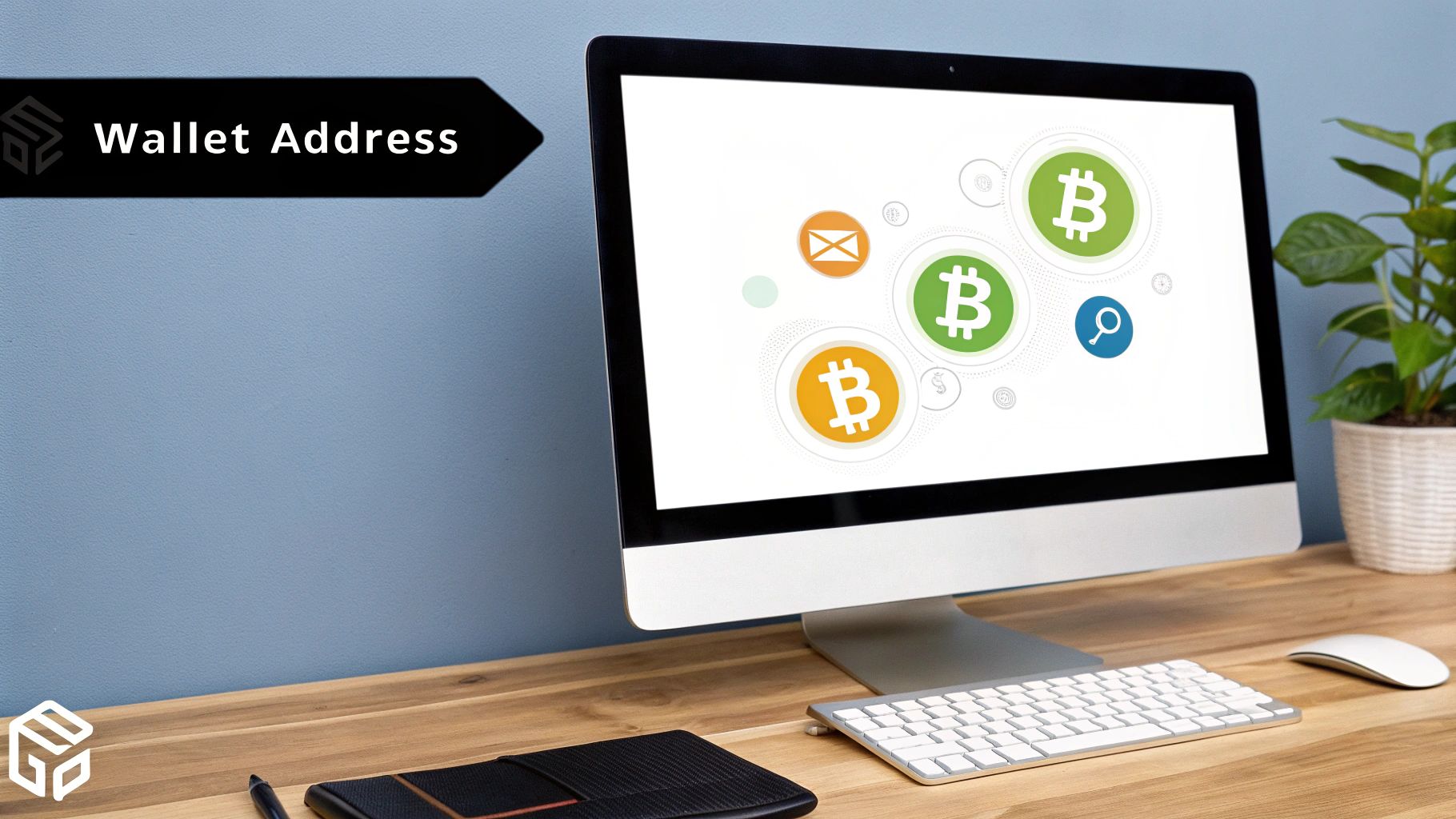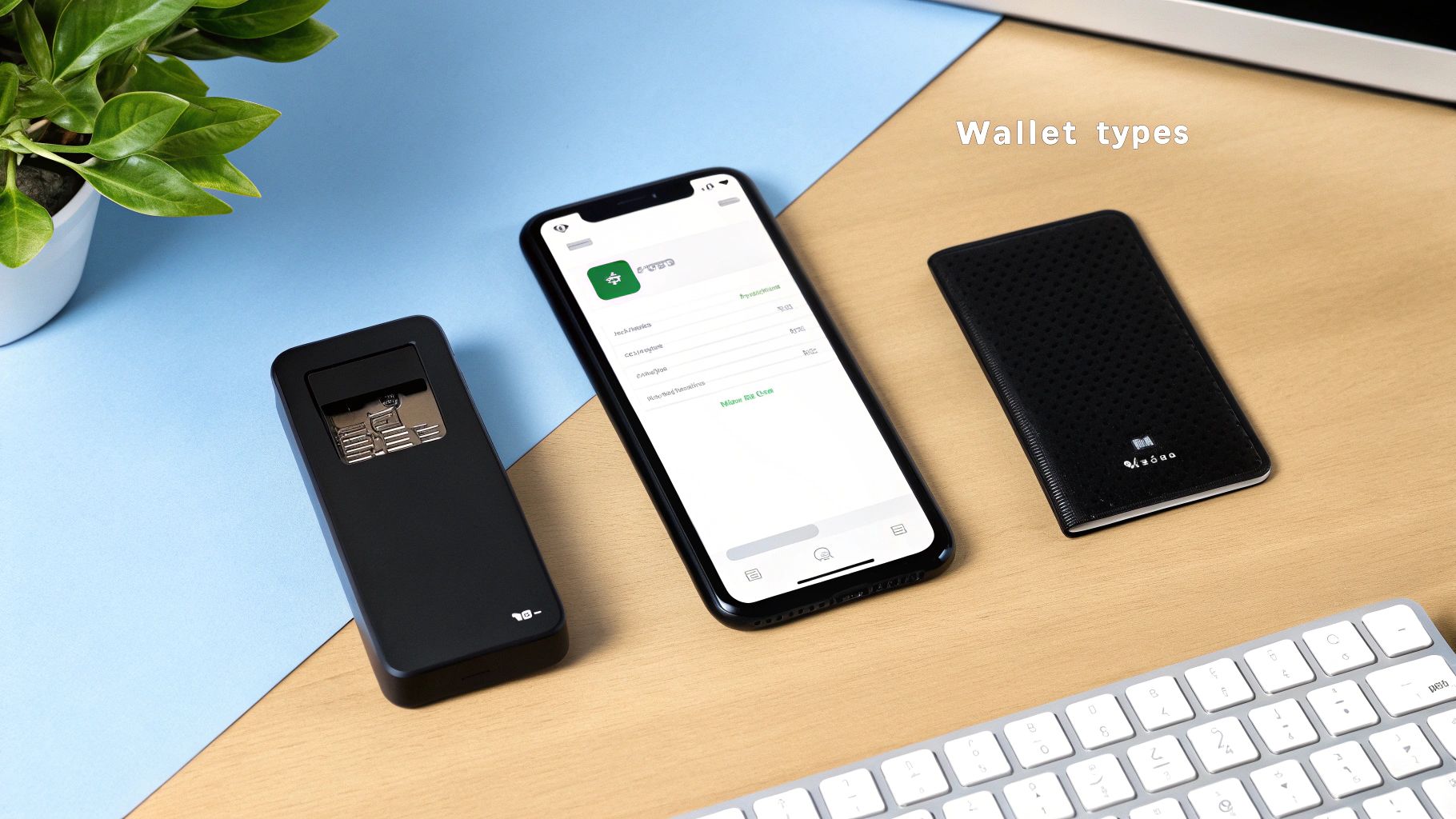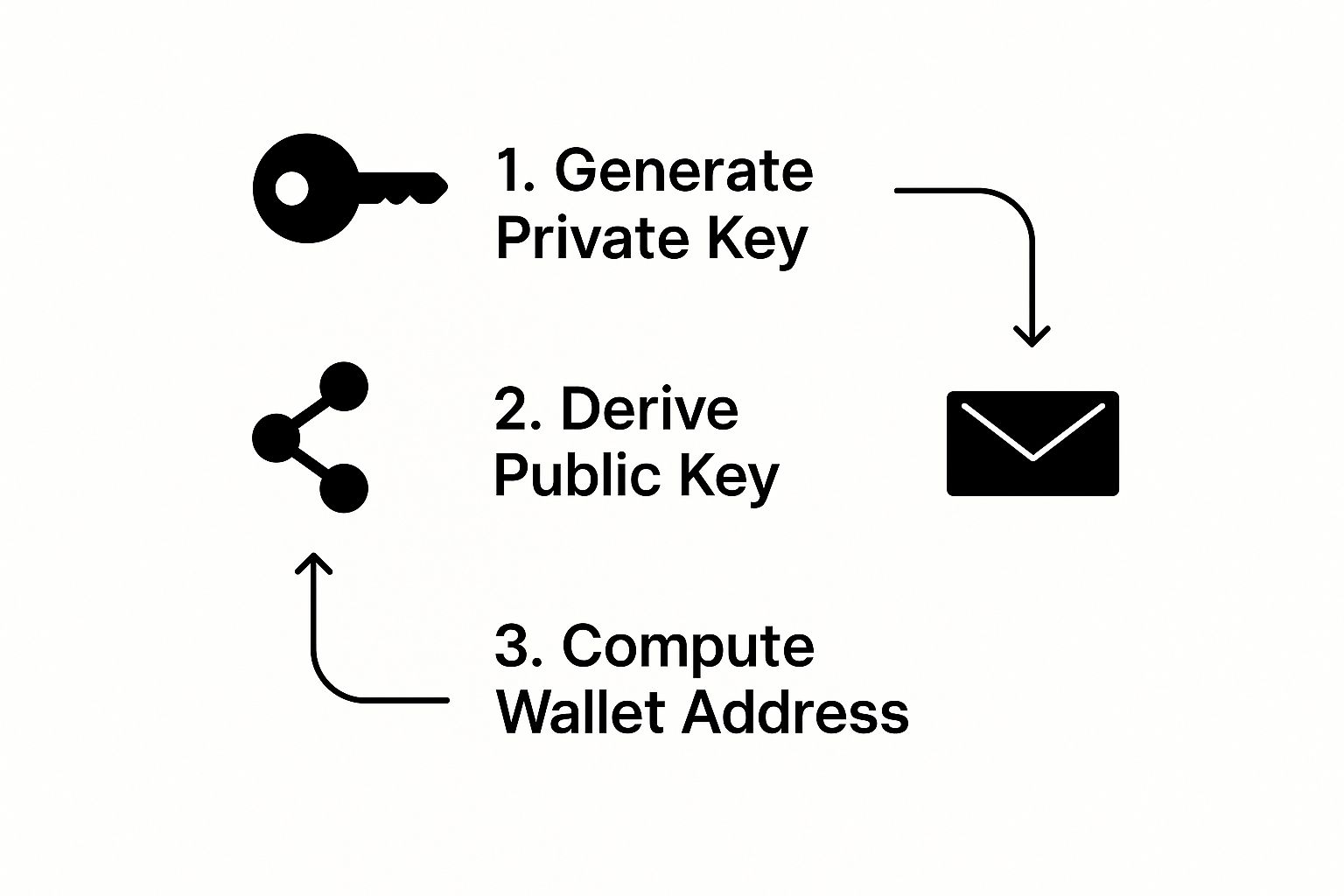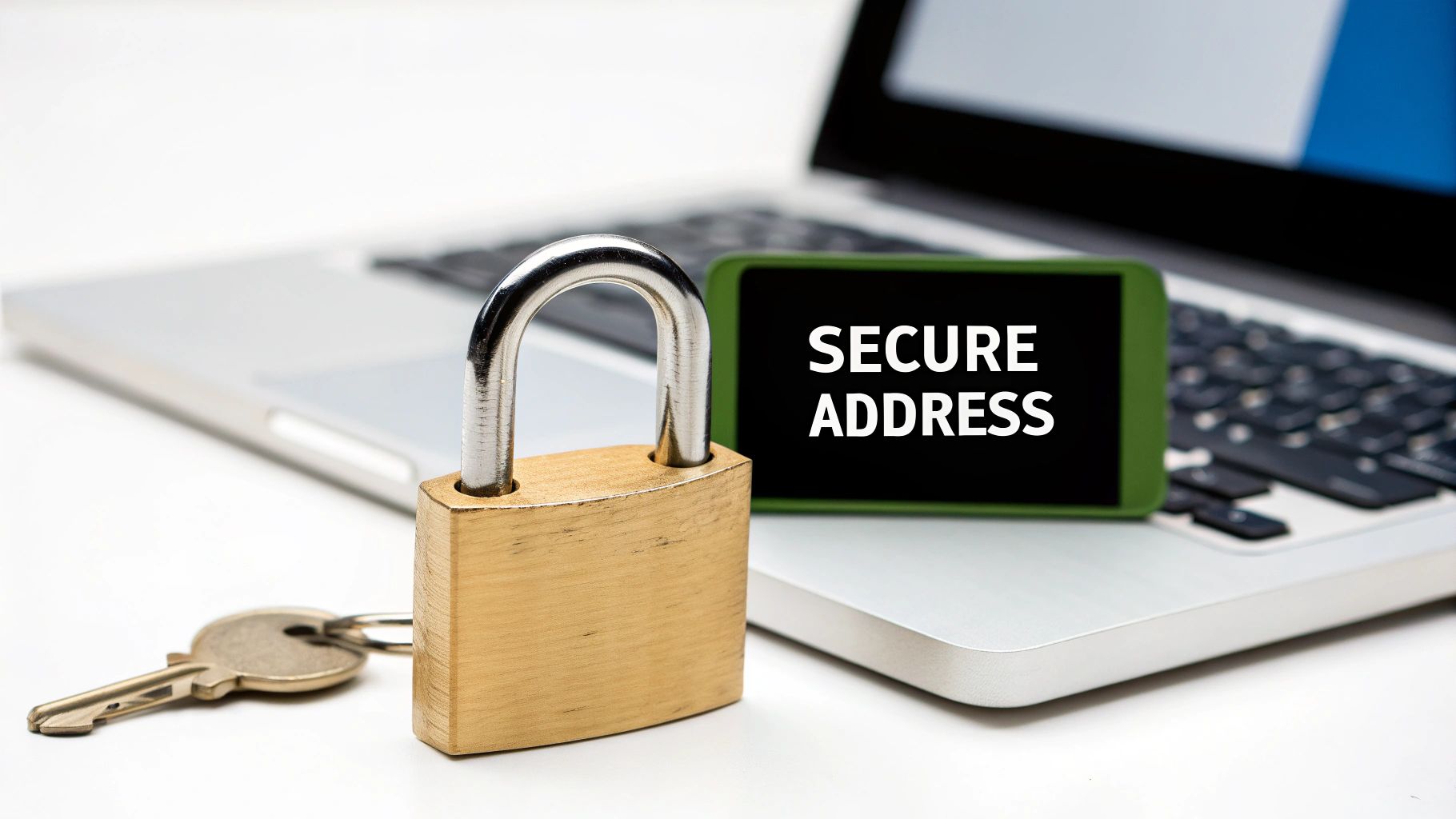
How to Create a Wallet Address Your Business Can Use
If you’re still manually creating and tracking crypto wallet addresses for your business, you’re creating a logistical headache and a serious security risk. Relying on a single address for all your payments might seem easy, but it’s a privacy nightmare and an absolute mess to reconcile. The only way to build a truly scalable and professional payment system is by automating the process.
Why Manual Wallet Management Is Holding You Back

Many businesses accepting crypto start by reusing the same address for every customer. It’s a simple starting point, but it's a model that breaks down quickly. Since every transaction is publicly visible on the blockchain, anyone can trace your revenue, monitor your customer activity, and get a clear picture of your business's financial health.
That lack of privacy is just the tip of the iceberg. Imagine trying to figure out which payment belongs to which customer when you have dozens of orders coming in. What happens when two people pay the exact same amount around the same time? It becomes a huge challenge for your bookkeeping and opens the door to costly mistakes.
The Shift To Automated Solutions
The right way to handle this is by generating a unique, secure address for every single transaction. This is precisely where a payment API like BlockBee becomes a game-changer. It handles the entire process for you, eliminating the friction and security risks that come with doing it all by hand. Instead of wrestling with spreadsheets, you get a clean, auditable trail of every transaction tied directly to a specific order.
The demand for better wallet solutions is exploding. The crypto wallet market was valued at USD 12.59 billion in 2024 and is on track to smash past USD 100 billion by 2033. This massive growth shows just how many users are looking for smarter, more secure tools.
Automating address generation takes you from a reactive, high-risk process to a proactive system that boosts security, privacy, and operational efficiency for every single payment you receive.
It’s not just a crypto phenomenon; the broader digital payment space is constantly evolving. Staying on top of trends in mobile wallet technology can provide valuable insights into where the entire industry is headed.
Manual vs Automated Wallet Address Generation
To see the difference clearly, here's a quick comparison of the two approaches.
| Feature | Manual Process | Automated Process (with BlockBee) |
|---|---|---|
| Speed | Slow, requires human intervention for each transaction. | Instantaneous, generated on-demand via API call. |
| Security | High risk of human error (e.g., sending the wrong address). | Minimized risk, addresses are system-generated. |
| Privacy | Poor, all transactions are linked to a single public address. | Excellent, each transaction has a unique, private address. |
| Scalability | Not scalable; becomes unmanageable with volume. | Highly scalable, handles thousands of transactions seamlessly. |
| Record Keeping | A nightmare; requires manual tracking in spreadsheets. | Effortless, transactions are automatically logged and tracked. |
Ultimately, automation frees you up to focus on your business instead of getting bogged down in the complex and risky details of crypto payment management. It's a fundamental step toward building a professional and reliable system.
The Keys and Addresses Behind Every Crypto Wallet

Before you start generating wallet addresses, it’s worth taking a moment to understand the three core components that make it all work. I like to think of them as a set of digital keys and a personal mailbox, all working together to keep your funds safe while letting you receive crypto from anyone, anywhere.
First, you have the private key. This is, without a doubt, the single most important piece of the puzzle. It’s a massive, randomly generated number that gives you—and only you—complete control over your cryptocurrency. Treat it like the master key to your entire vault. It’s for your eyes only.
From that secret key, a public key is mathematically derived. This is strictly a one-way street; it’s simple to create a public key from your private one, but it's virtually impossible to do the reverse. This ingenious design is what underpins the security of the entire system.
Finally, your wallet address is generated from your public key. Think of this as your crypto bank account number or a unique email address just for money. This is the only piece of information you should ever share to get paid. It’s a public identifier that lets funds in but keeps everyone else out.
The Cryptographic Journey From Key to Address
So, how does this all happen? The journey from a private key to a public-facing address is a pretty sophisticated cryptographic process. For a coin like Bitcoin, it all starts with generating a private key using what's called elliptic curve cryptography (ECC).
Next, a complex ECC multiplication process derives the public key from the private one in a secure, irreversible step. The public key is then put through multiple hashing algorithms to produce the final, shorter wallet address. This multi-step hashing makes it computationally impossible to reverse the process and get back to the private key.
Key Takeaway: Your private key is the master control for your funds. Your public key is for verifying ownership. Your wallet address is for receiving payments. Never, ever share your private key with anyone.
Once you get your head around this relationship, managing your crypto securely becomes much more intuitive. For a deeper dive into protecting this critical asset, I highly recommend reading our guide on private key security.
Creating a Wallet Address with a Simple API Call
Alright, let's move from theory to action. Generating a unique address for every single transaction sounds like a lot of work, but it doesn't have to be a major development headache. With a service like BlockBee, you can spin up a new wallet address with a single, straightforward API call that takes just seconds to set up.
First things first, you'll need your API key. You can find this in your BlockBee dashboard. Think of this key as the password to your account—it authenticates your requests and links every generated address back to you. It's critical to keep this key secure and never, ever expose it in front-end code like HTML or JavaScript.
Putting Together Your First API Request
Got your key? Great. Now you're ready to make the actual request. The whole process is designed to be as simple as possible, even if you’re not an API guru. You’ll be sending a request to the creation endpoint with a few key pieces of information to get exactly the address you need.
Here’s a quick rundown of what you'll need to include:
- API Key: Your secret key for authentication.
- Cryptocurrency: The specific coin you want an address for (e.g.,
btc,eth,usdt_trc20). - Callback URL: This is huge. It’s a URL on your server that BlockBee pings the moment a payment arrives.
- Parameters: You can also pass along optional data, like an
order_id, which makes tracking payments on your end a breeze.
For a full breakdown of every parameter and all the supported coins, the official BlockBee API documentation is your best friend.
This visual below really helps demystify the cryptographic process that happens behind the scenes every time an address is created. It takes a complex series of steps and lays it out cleanly.

The journey from a private key to a public address is a one-way street, and that’s precisely what makes cryptocurrency so secure. You can’t reverse the process.
Let’s talk about a real-world scenario. Say you run an e-commerce shop and a customer is ready to pay for their order with Bitcoin. Your system would make an API call specifying the coin ticker (btc) and your unique callback URL.
In an instant, the API fires back a simple JSON response. This response contains the new address_in, which you can then show to your customer on the checkout page. The entire exchange is incredibly fast, so your customer gets a seamless experience without any frustrating delays.
The real game-changer here is the callback system. As soon as a payment lands in that address, BlockBee sends an automated notification to your URL. This lets your system instantly confirm the order and mark it as paid, completely eliminating the need for you to manually check wallets.
From a developer’s perspective, having solid examples is everything. The documentation provides exactly that.
The BlockBee docs are filled with ready-to-use code snippets in different programming languages. This means your technical team can get the integration done in a fraction of the time it would otherwise take.
Your Central Hub for Generated Addresses

Automating address generation with an API is a game-changer for efficiency. But let’s be honest, automation without a good way to check in on things can be a bit stressful. Once you've got your system creating wallet addresses on the fly, you absolutely need a central command center to keep track of it all. This is where a solid dashboard becomes your best friend, perfectly connecting your automated processes with the hands-on oversight you need.
The BlockBee dashboard is built specifically for this, giving you a live, bird's-eye view of everything happening with your crypto payments. Forget digging through server logs or running database queries. You can see every single address your API generates, all in one clean interface. It’s the quickest way to confirm your integration is humming along just as it should.
Keeping Tabs on Payments and Balances
The dashboard does more than just list addresses—it brings your entire payment workflow to life. You can watch transactions as they come in, see their confirmation status on the blockchain, and check the balance of any address. This level of transparency is essential for good customer support and straightforward financial reconciliation.
Imagine a customer emails you saying they sent a payment that hasn't shown up. Instead of a drawn-out investigation, you can simply pull up their assigned address and see its full transaction history in seconds. Problem solved.
A truly useful dashboard isn't just about showing data; it's about providing clear, actionable information. It takes complex blockchain details and turns them into something you can actually use to run your business better.
Smart Filtering and Easy Troubleshooting
When you're juggling multiple cryptocurrencies and hundreds or thousands of transactions, you need to be able to find things fast. This is where good filtering and logging tools make all the difference.
You get practical features that you'll end up using daily:
- Filter by Crypto: Need to see just your Bitcoin, Ethereum, or USDT activity? One click and you’re there.
- Check Callback Logs: If a payment notification seems to have gone missing, you can dive right into the logs. You’ll see the exact request and the server's response, which cuts troubleshooting time from hours to minutes.
This powerful combination of API automation and an intuitive dashboard gives you the best of both worlds. You get a scalable, efficient system with the hands-on control needed for complete peace of mind.
Keeping Your Crypto Operations and API Keys Secure
https://www.youtube.com/embed/Z5fi--FYnkw
Getting a new wallet address is simple enough, but that’s just the beginning. The real challenge is locking down your entire workflow to keep your funds safe. When you're working with an API to generate addresses, think of your API key as the master key to your kingdom. It absolutely cannot be left exposed in client-side code, like in your website’s JavaScript or a mobile app. That’s just asking for trouble.
To do this right, every API request must originate from your own secure server. It’s also critical that your callback URL—the endpoint BlockBee uses to notify you of payments—is protected with HTTPS. If you stick with an unencrypted HTTP callback, all that sensitive transaction data is sent in plain text, making it incredibly easy for someone to intercept.
Foundational Security Practices
Here’s a piece of advice I always give: adopt a "one address per transaction" policy. It's a game-changer for both security and privacy.
With the number of identity-verified crypto users now over 560 million worldwide, customers expect a professional and private experience. When you reuse addresses, you're essentially creating a public ledger of every transaction a customer has ever made with you. That's a huge privacy blunder. You can dig into the data behind this explosive growth over on Statista.
These aren't just minor suggestions—they are the bedrock of a secure crypto payment system.
Securing your API isn't just a technical chore; it's a fundamental part of your business. A single exposed key or an unencrypted callback can bring your entire operation down, costing you both money and your customers' trust.
It's also worth your time to get familiar with the different secure REST API authentication methods out there. On that same note, the recovery phrase for your main wallet is just as vital. We've put together a guide with some crucial tips on proper seed phrase storage that you should definitely check out.
Common Questions About Generating Wallet Addresses
When you first start working with automated crypto payments, a few questions always seem to come up. Getting your head around the details of how these addresses work through an API is crucial for keeping your payments running smoothly and securely. Let's dig into some of the things people often ask.
Can I Just Reuse the Same Wallet Address for Different Customers?
You could, but you absolutely shouldn't. From a business perspective, it's a huge privacy blunder. Every time you reuse an address, you're tying all those payments together on a public blockchain. Anyone can look it up.
This means your customers' transaction histories are exposed, and worse, your competitors can easily track your sales volume, payment frequency, and even estimate your revenue. It’s like leaving your company’s financial records out on the street.
The gold standard is simple: a fresh, unique address for every single transaction. This is the cornerstone of how to create a wallet address professionally. Using an API like BlockBee’s handles this for you automatically, so you get top-notch privacy for your business and your customers without lifting a finger.
Key Takeaway: Think of addresses as single-use. Reusing them is a serious privacy risk that exposes your business and customer data. A "one-time-use" policy is the only way to go.
Do I Have to Run My Own Blockchain Node to Do This?
Nope, and that's a massive relief. Running your own full node for each cryptocurrency you accept is a huge technical and financial commitment. You'd be on the hook for constant maintenance, security, and making sure everything stays perfectly synced with the network—it's a full-time job in itself.
This is where a service like BlockBee steps in to manage all that heavy lifting. You get to interact with the blockchain directly through a straightforward API call, letting you generate addresses whenever you need them, without any of the backend headaches. It's a huge saving in time, money, and stress.
What Happens to the Crypto After a Customer Pays to a Generated Address?
It gets sent straight to you. When you set up your system, you'll specify your main business wallet addresses for each coin. As soon as a payment hits one of the generated addresses and gets enough blockchain confirmations, the funds are automatically forwarded to your designated wallet.
Your system is kept in the loop the entire time. BlockBee sends an instant notification to your callback URL when the payment is detected, when it's confirmed, and when it's forwarded. You always know exactly where the money is.
Ready to stop worrying about the technical details and start accepting crypto payments the easy way? BlockBee gives you the API and dashboard you need to generate secure, on-demand wallet addresses and scale up. Get started for free today.
